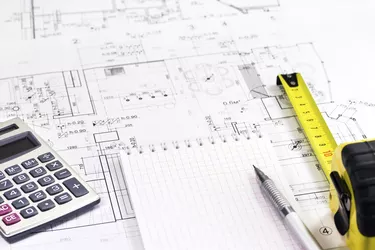
While there are many factors that influence the value of a home or other building, gross living area is perhaps the most commonly considered. Gross living area is defined as the sum of the indoor, finished, completely above-ground spaces. Attics, attached garages and entryways are excluded, even if they are finished. In addition, the requirement that gross living area be completely above ground and indoors means that basements, decks and patios must be excluded as well.
Measurements and Calculations
Video of the Day
Step 1
Estimate the gross living area. If available, use blueprints to obtain the approximate dimensions of all indoor rooms that are completely above ground.
Video of the Day
Step 2
Measure the external dimensions for buildings other than condos and cooperatives, i.e. the outside of the building, for each floor of the building. For condos and cooperatives, use the internal dimensions.
Step 3
Divide floors into common shapes if there are odd shapes or cutouts. For example, if one of the floors has beveled corners, then divide that floor into rectangles and triangles.
Step 4
Adjust your calculations if opposing walls are not parallel in order to account for the discrepancy. This can be accomplished by dividing the area into a rectangle and the appropriate number of triangles.
Step 5
Calculate the area of each floor using the following area formulas -- rectangles: length x width; circles: πr² where 3.1416 can be used as an approximation for π; triangles: base x height/2. Compare your values to the estimates obtained from the blueprints. If they are not close, then double-check your calculations.
Step 6
Subtract the area of a room or stairwell from each floor other than the first if they span multiple stories. For example, if a 15-by-20-foot foyer is two stories tall, then those 300 square feet would count towards the gross living area on the first floor but not on the second floor. The total for the second story would thus have to be reduced by 300 square feet.
Step 7
Add up all of the floor totals to arrive at the gross living area. Remember not to include the basement as a floor, even if the basement is finished, partially above ground and has windows.
Tip
While areas such as basements, garages, decks, patios and attics do not count towards the gross living area, they can be reported elsewhere in real estate advertisements.
Warning
Factors other than gross living area affect the value of real estate, so do not base your real estate valuation solely on the gross living area.
Blueprints are useful for estimates but should not be relied upon when obtaining gross living area values. Gross living area should always be calculated based on physical measurements of the completed building.
Things You'll Need
Blueprints, if available
Calculator
Measuring tape